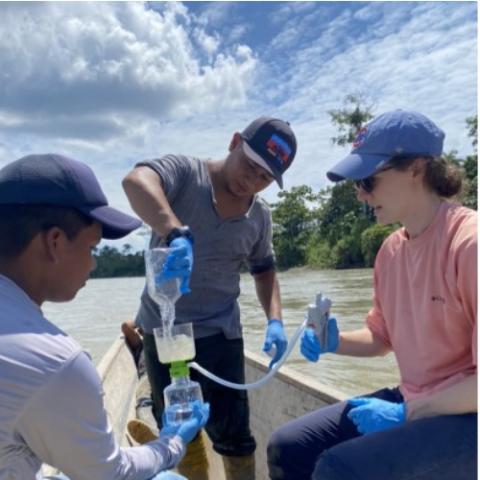Impacts of Artisanal Gold Mining on Humans and the Environment (2023-2024)
Artisanal and small-scale gold mining (ASGM) practices are widespread and persistent across Latin America. Driven by the global demand for gold, these activities contribute to negative impacts such as extensive deforestation, degradation of highly biodiverse ecosystems and the release of toxic chemicals such as mercury that endanger the health of communities living downstream.
Solutions to this challenge require combinations of technological and policy interventions that can promote the adoption of new practices while also recognize the socioeconomic vulnerabilities that drive individuals to engage in informal (and often illegal) gold mining.
This team explored the interconnections of the environmental impacts, human health vulnerabilities and policy needs as they relate to impacts of ASGM in Peru and Ecuador. Members of the team conducted environmental field studies of river water quality near mining, surveyed communities near gold mining activity and engaged with individuals participating in the gold mining sector.
Learn more about this team’s work by reading their team profile.
Timing
Summer 2023 – Summer 2024
Team Outputs
Evaluating and Mitigating the Damaging Effects of Mercury-Based Artisanal and Small-Scale Gold Mining in South America (Poster presented at Fortin Foundation Bass Connections Showcase, April 17, 2024)
Panning for Solutions to the Challenges of Informal Gold Mining (Team profile; 2024 Fortin Foundation Bass Connections Virtual Showcase)
Impacts of Artisanal Gold Mining on Humans and the Environment (Lightning talk; 2024 Fortin Foundation Bass Connections Showcase)
This Team in the News
Predicting Cyanide’s Role in Making Mercury More Dangerous
See earlier related team, Field Testing a Mercury Capture System for Artisanal Gold Mining (2021-2022).
Image: Members of the Bass Connections team engage in field work. (Photo courtesy of the Impacts of Artisanal Gold Mining on Humans and the Environment project team)

Team Leaders
- Heileen Hsu-Kim, Pratt School of Engineering-Civil & Environmental Engineering
- William Pan, Nicholas School of the Environment-Environmental Sciences and Policy
- Shannon Plunkett, Pratt School of Engineering–Civil and Environmental Engineering–Ph.D. Student
- Daniel Tobin, Nicholas School of the Environment–Environment–Ph.D. Student
/graduate Team Members
-
Alex Diaz Herrera, Environmental Policy-PHD
-
Jasmine Parham, Biology - PHD
-
Paula Sarmiento, Environmental Policy-PHD
-
Payton Wood, Global Health - Cer
-
Alejandra del Campo Farro, Master of Environmental Management, Business and Environment
/undergraduate Team Members
-
Caroline Hancock, Environmental Sci/Policy (AB)
-
Chloe McGeehan
-
Njoki Mwangi, Economics (AB)
-
Abigail Walden
/yfaculty/staff Team Members
-
Emily Bernhardt, Arts & Sciences-Biology
/zcommunity Team Members
-
Andrea Carolina Encalada, Universidad San Francisco de Quito
-
Carlos Mena, Universidad San Francisco de Quito
-
Melany Ruiz-Urigen, Universidad San Francisco de Quito
